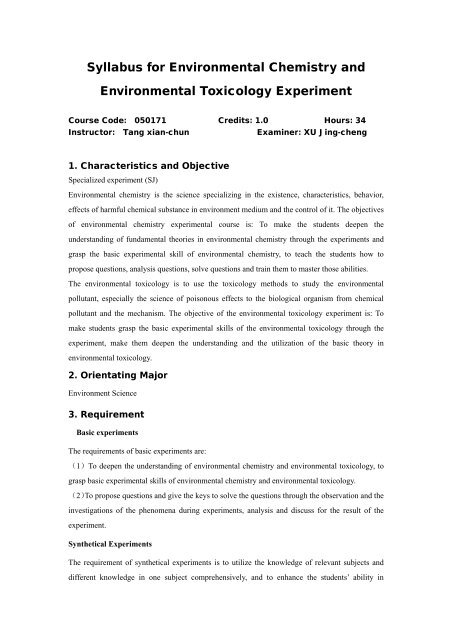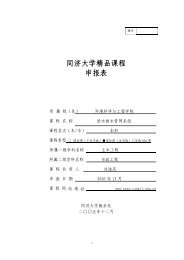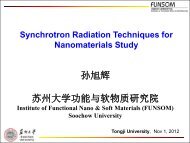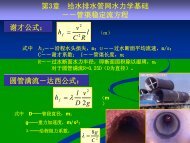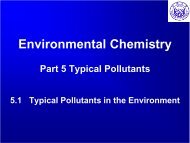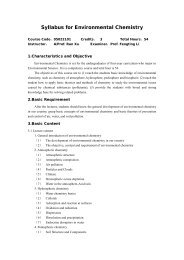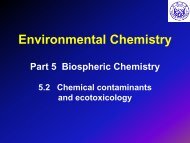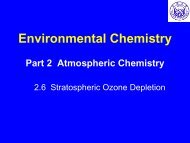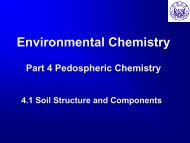Syllabus for Environmental Chemistry and Environmental ...
Syllabus for Environmental Chemistry and Environmental ...
Syllabus for Environmental Chemistry and Environmental ...
You also want an ePaper? Increase the reach of your titles
YUMPU automatically turns print PDFs into web optimized ePapers that Google loves.
<strong>Syllabus</strong> <strong>for</strong> <strong>Environmental</strong> <strong>Chemistry</strong> <strong>and</strong><br />
<strong>Environmental</strong> Toxicology Experiment<br />
Course Code: 050171 Credits: 1.0 Hours: 34<br />
Instructor: Tang xian-chun<br />
Examiner: XU Jing-cheng<br />
1. Characteristics <strong>and</strong> Objective<br />
Specialized experiment (SJ)<br />
<strong>Environmental</strong> chemistry is the science specializing in the existence, characteristics, behavior,<br />
effects of harmful chemical substance in environment medium <strong>and</strong> the control of it. The objectives<br />
of environmental chemistry experimental course is: To make the students deepen the<br />
underst<strong>and</strong>ing of fundamental theories in environmental chemistry through the experiments <strong>and</strong><br />
grasp the basic experimental skill of environmental chemistry, to teach the students how to<br />
propose questions, analysis questions, solve questions <strong>and</strong> train them to master those abilities.<br />
The environmental toxicology is to use the toxicology methods to study the environmental<br />
pollutant, especially the science of poisonous effects to the biological organism from chemical<br />
pollutant <strong>and</strong> the mechanism. The objective of the environmental toxicology experiment is: To<br />
make students grasp the basic experimental skills of the environmental toxicology through the<br />
experiment, make them deepen the underst<strong>and</strong>ing <strong>and</strong> the utilization of the basic theory in<br />
environmental toxicology.<br />
2. Orientating Major<br />
Environment Science<br />
3. Requirement<br />
Basic experiments<br />
The requirements of basic experiments are:<br />
(1)To deepen the underst<strong>and</strong>ing of environmental chemistry <strong>and</strong> environmental toxicology, to<br />
grasp basic experimental skills of environmental chemistry <strong>and</strong> environmental toxicology.<br />
(2)To propose questions <strong>and</strong> give the keys to solve the questions through the observation <strong>and</strong> the<br />
investigations of the phenomena during experiments, analysis <strong>and</strong> discuss <strong>for</strong> the result of the<br />
experiment.<br />
Synthetical Experiments<br />
The requirement of synthetical experiments is to utilize the knowledge of relevant subjects <strong>and</strong><br />
different knowledge in one subject comprehensively, <strong>and</strong> to enhance the students’ ability in
analysis <strong>and</strong> resolution of problems.<br />
4. Basic Content<br />
Basic experiments<br />
There are 6 fundamental experiments in this course, mainly involves: The change of toxicity while<br />
biology (plant, bacterium <strong>and</strong> so on) receiving pollutant in the water; the existence, the position,<br />
the alteration of physical <strong>and</strong> chemical characteristic, <strong>and</strong> the disposal of organism or heavy metal<br />
pollutant in water or soil environmental medium.<br />
Synthetical Experiments<br />
The main contents of synthetical experiments are to guide the students utilizing the knowledge<br />
from environmental monitoring <strong>and</strong> environmental chemistry courses through the operation of the<br />
experiments of transportation <strong>and</strong> trans<strong>for</strong>mation of heavy metal in the soil - plant system, to find<br />
the regularity in the transportation <strong>and</strong> trans<strong>for</strong>mation of the pollutants <strong>and</strong> to propose the<br />
measurements <strong>for</strong> it.<br />
The analytical <strong>and</strong> appraising experiment <strong>for</strong> the eutrophication extent of water involves the<br />
relevant knowledge <strong>and</strong> skills in environmental microbiology, environmental monitoring,<br />
<strong>Environmental</strong> Assessment courses, furthermore, to train the students utilizing series of<br />
knowledge <strong>and</strong> proposing the resolution to the water eutrophication through the experiment is<br />
another important portion.<br />
Series project<br />
experiment<br />
00602<br />
021<br />
of<br />
Brief contents<br />
Category<br />
valid<br />
ate<br />
synthetic<br />
open<br />
ing<br />
Each<br />
gou<br />
p of<br />
hour<br />
pop<br />
s<br />
ulat<br />
ion<br />
s<br />
learning the principle <strong>and</strong><br />
method of the<br />
determinations chromium;<br />
underst<strong>and</strong>ing of the<br />
The existence,<br />
chromium shape distribution<br />
the position <strong>and</strong><br />
In water body, Underst<strong>and</strong>ing<br />
the elimination<br />
√<br />
the method of the mutually<br />
of chromium<br />
trans<strong>for</strong>ms in each kind of<br />
in wastewater<br />
shape<br />
chromium,<br />
2 3<br />
Underst<strong>and</strong>ing how to<br />
removein the chromium in<br />
water body<br />
Apparatus<br />
equipments<br />
Obviously<br />
spectrophotometer 15<br />
<strong>and</strong> so on<br />
Number of main<br />
<strong>and</strong><br />
reduplicate comsumpted<br />
devices materials<br />
Labarotary<br />
reagent flask,<br />
Environment<br />
Sys-Diphenyl<br />
institute<br />
Czrbazide,H 2 SO 4<br />
center<br />
,KMnO 4 ,<strong>and</strong> so<br />
laboratory<br />
on<br />
remark<br />
00602<br />
022<br />
The underst<strong>and</strong>ing related<br />
The absorbing influence factor to copper<br />
behavior of adsorption in the soil, learing √ 4<br />
copper in soil to establish the adsorption<br />
uni<strong>for</strong>m temperature method<br />
Atomic absorption<br />
spectrophotometer<br />
,constant<br />
15<br />
temperature<br />
oscillator,centrifug<br />
e,acidometer<br />
Copper st<strong>and</strong>ard<br />
solution, Environment<br />
biochemistry institute<br />
reagent humic center<br />
acid, weighting laboratory<br />
bottle
00602<br />
023<br />
Deepen the underst<strong>and</strong>ing of<br />
the oil pollution in the<br />
the existence<br />
environment , grasping<br />
<strong>and</strong><br />
analysis method <strong>and</strong> the<br />
components of<br />
technology, in the oil , √<br />
oily wastewater<br />
learning how to use the<br />
<strong>and</strong> it’s<br />
infrared oil analyzer, analyse<br />
elimination<br />
the shape <strong>and</strong> component in<br />
2 4<br />
the waste water oil<br />
Infrared<br />
photometric oil<br />
15<br />
analyzer, the small<br />
air pump<br />
Tap funnel,<br />
hourglass, Environment<br />
weighting bottle, institute<br />
CCl 4 ,Oil reservior center<br />
liquid, Na 2 SO 4 , laboratory<br />
H 2 SO 4<br />
00602<br />
024<br />
Underst<strong>and</strong>ing<br />
photochemistry oxidation<br />
mechanism of the phenol in<br />
Photo- chemical<br />
water, determination<br />
oxidation of<br />
√ 2 4<br />
degeneration speed of the<br />
phenol in water<br />
phenol under light function,<br />
<strong>and</strong> obtaining the light<br />
degeneration speed constant<br />
Obviously<br />
spectrophotometer<br />
15<br />
, photochemistry<br />
reactor<br />
25ml measuring<br />
flask,measuring<br />
cylinder,beaker,4<br />
-Amino-antilyrine,<br />
potassium<br />
ferricyanide,<br />
high-pressured<br />
mercury lamp<br />
Environment<br />
institute<br />
center<br />
laboratory<br />
00602<br />
025<br />
00602<br />
026<br />
00602<br />
027<br />
The<br />
physiological<br />
toxicity<br />
experiment<br />
plants<br />
Biological<br />
toxicity<br />
experiment<br />
photobacterium<br />
The<br />
transportation<br />
<strong>and</strong><br />
trans<strong>for</strong>mation of<br />
heavy metal in<br />
soil<br />
observation<br />
the<br />
physiological change of the<br />
plant root point Using the<br />
toxicology experimental<br />
technique in the polluted √ 2 6<br />
of water. Invetigation of the<br />
influence of plant root point in<br />
different concentration of<br />
pollutant.<br />
Underst<strong>and</strong>ing the method<br />
<strong>and</strong> basic principle of the<br />
photobacteria by biological<br />
toxicity test. Grasps the<br />
biological toxic reflectoscope √ 2 3<br />
of<br />
reflector the basic structure,<br />
the principle, <strong>and</strong> can carry on<br />
the correct operation <strong>and</strong> the<br />
use<br />
underst<strong>and</strong>ing the basic<br />
principle <strong>and</strong> the operating<br />
per<strong>for</strong>mance of the atom<br />
absorb spectroscope.<br />
Grasping the atomabsorb<br />
determination operating<br />
procedure by in soil <strong>and</strong> the<br />
plant with the atom the heavy<br />
metal content, in the<br />
underst<strong>and</strong>ing soil - plant<br />
system the heavy metal<br />
migration trans<strong>for</strong>mation rule<br />
√ 2 4<br />
Microscope,<br />
refrigerator,<br />
15<br />
biochemistry raise<br />
box<br />
Biological toxic<br />
reflectoscope,<br />
constant<br />
temperature<br />
oscillator,<br />
biochemistry raise<br />
box,<br />
high-pressured<br />
antiseptic pot<br />
Atomic absorption<br />
15<br />
spectrophotometer<br />
15<br />
<strong>and</strong> so on<br />
the chemical<br />
poisonous<br />
material, the<br />
plant root point,<br />
the acetic acid<br />
Environment<br />
magenta liquid,<br />
institute<br />
the methyl<br />
center<br />
alcohol - glacial<br />
laboratory<br />
acetic acid, the<br />
ethyl alcohol, the<br />
beaker, the<br />
graduated<br />
cylinder<br />
half minim<br />
buret,the fungus<br />
(brightly shines Environment<br />
the bacillus T3 institute<br />
small kind), the center<br />
sodium chloride, laboratory<br />
the mercuric<br />
chloride<br />
the beaker, the<br />
graduated<br />
cylinder, the nitric Environment<br />
acid, the sulfuric institute<br />
acid, the oxidant, center<br />
the metal reserve laboratory<br />
fluid, the nylon<br />
sieve<br />
00602<br />
028<br />
Grasping the principle<br />
<strong>and</strong> the method of<br />
The evaluation of determination to the total<br />
extent of water phosphorus, the total nitrogen<br />
eutrophication <strong>and</strong> the chl-a, evaluating<br />
eutrophication condition in<br />
water body<br />
√ 2 6<br />
Obviously<br />
spectrophotometer<br />
, centrifuge, 15<br />
high-pressured<br />
antiseptic pot<br />
Liquid moving<br />
tube, ammonium<br />
Environment<br />
persulfate,<br />
institute<br />
acetone (or N, N<br />
center<br />
- dimethyl<br />
laboratory<br />
<strong>for</strong>mamide<br />
(DMF))<br />
5.Experiment Preview <strong>and</strong> Report Requirement <strong>and</strong> Assessment<br />
(1) Experiment preview: underst<strong>and</strong>ing the relative knowledge <strong>and</strong> the instructions of relevant<br />
equipments, to carry on the experiment smoothly.
(2) Report requirement : include the experimental principle, the experiment process, the<br />
experiment datum, the experiment result, the experiment analysis <strong>and</strong> the experiment conclusion.<br />
(3)Assessment: experiment examination according to the experiment report.<br />
6.Time Distribution<br />
The total<br />
experiment time<br />
Theoretical<br />
study time<br />
Experimenti<br />
ng time<br />
Practicing<br />
time<br />
Practicing<br />
on-site time<br />
Computer<br />
studying<br />
time<br />
Exame time<br />
34 0 34<br />
7.Textbooks, Guide <strong>for</strong> Experiment <strong>and</strong> Main Reference Books<br />
Textbooks <strong>and</strong> Guide <strong>for</strong> Experiment<br />
[1] Zhang Fei-juan,Xu Jing-cheng.Experiment <strong>for</strong> environment engineering. Higher education<br />
press,2006. (in chinese)<br />
[2] Supplementary materials <strong>for</strong> Experiment of environmental chemistry <strong>and</strong> environmental<br />
toxicology(exclusive)<br />
Main Reference Book<br />
[1] XiaoLin, YangLiuyan,et al. The Experiment skills of environmental microbiology. Chinese<br />
environmental science press,2004 (in chinese)<br />
[2] Dong De-ming, Zhu Li-zhong.Experiment of environmental chemistry. Higher education<br />
press,2002 (in chinese)<br />
[3] Dai Shu-gui.<strong>Environmental</strong> chemistry. Higher education press,1996 (in chinese)<br />
[4] Meng Zi-qiang.Basic environmental toxicology. Higher education press ,2003 (in chinese)<br />
[5] Hui Xiu-juan.<strong>Environmental</strong> toxicology. Chemical industry press,2003 (in chinese)<br />
[6] Lu Yong-sen.<strong>Environmental</strong> assentent. Tongji university press,2002 (in chinese)


